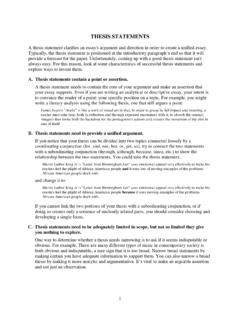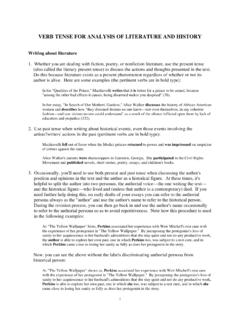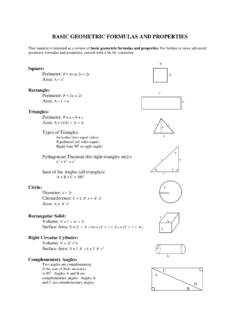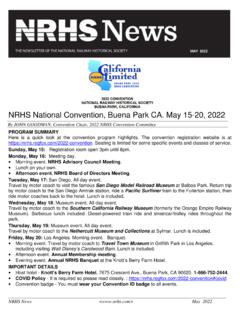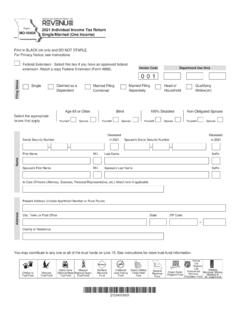Transcription of SENTENCE COMBINING: Part One - Texas State University
1 SENTENCE COMBINING: Part One Once you have mastered writing a clear, grammatically correct simple SENTENCE (a SENTENCE that contains a subject and a predicate and expresses a complete thought), you can begin to improve your writing by practicing combining sentences. Combining sentences not only lends variety to your writing but also helps the reader to follow the direction of your argument smoothly. It adds to the tools you have to create dramatic emphasis and thus to more effectively persuade your audience. Besides the simple SENTENCE , you can create three more SENTENCE patterns by combining sentences through coordination and subordination: 1. a compound SENTENCE , which consists of two or more main or independent clauses (clauses that can stand alone as sentences) joined by a coordinating conjunction and a comma, by a semicolon alone (when the thoughts expressed in the clauses are of relatively equal value), or by a conjunctive adverb ( , therefore, however, instead, then) and a semicolon; 2.
2 A complex SENTENCE , which contains one independent clause and one or more subordinate clauses; 3. a compound-complex SENTENCE , which has two or more independent clauses and at least one subordinate clause. Compound SentencesA. Compound sentences created with coordinating conjunctions The coordinating conjunctions are and (shows addition), or (shows choice), but and yet (show contrast), for and so (show logical consequence), nor (shows addition of a negative point). Together with a comma, coordinating conjunctions can join two independent clauses. Example: Life is short. [independent clause] Art is long. [independent clause] Life is short, but art is long.
3 B. Compound sentences created with a semicolon This method of joining sentences is only recommended for sentences whose ideas are related and of equal significance. Example: The house was empty; everyone had gone. C. Compound sentences created with a conjunctive adverb and a semicolon and a comma (when the conjunctive adverb immediately follows the semicolon) Examples: The price of oil has risen sharply; therefore, wood stoves are popular again. or The price of oil has risen sharply; wood stoves are therefore popular again. A conjunctive adverb is a word or phrase that indicates the relationship between clauses it joins but is usually weightier and more emphatic than a conjunction.
4 Conjunctive adverbs specify one of the following relations: 1. Addition: besides, furthermore, moreover, or in addition The general had complete confidence in his soldiers' training and valor; furthermore, he considered his battle plan a work of genius. 2. Likeness: likewise, similarly, or in the same way Many young Englishmen condemned the English war against France in the 1790s; likewise, many young Americans condemned the American war against Vietnam in the 1960s. 3. Contrast: however, nevertheless, still, nonetheless, conversely, otherwise, instead, in contrast, or on the other hand Einstein's theory of relativity was largely a product of speculation; experiments made within the last fifty years, however, have confirmed its basic points.
5 4. Cause-and-effect: accordingly, consequently, hence, therefore, as a result, or for this reason Carl spent too many nights going to parties his first semester in college; for this reason, he missed more classes than he should have. 5. Means-and-end: thus, thereby, by this means, or in this manner When our guinea pigs became listless, we took them to the doctor; thus, we were able to stop their illness before it became too grave. 6. Reinforcement: for example, for instance, in fact, in particular, or indeed My son hates tee-ball; in fact, he hates it so much that he walked from third base during his last game of the season and stomped on home plate.
6 7. Time: meanwhile, then, subsequently, afterward, earlier, and later We went to the voodoo museum; afterward, we went to a cemetery and found the grave of Marie Laveau. Complex Sentences A SENTENCE is complex if it contains one main clause and one or more subordinate clauses. Some common subordinating conjunctions include after, although, as, as if, because, before, even though, if, in order that, once, since, so that, than, that, though, unless, until, when, where, while. Example: The railroad finally came, though many businesses had already left the area by then. [Main clause followed by subordinate clause] Compound-complex sentences Compound-complex sentences have two or more independent clauses and at least one subordinate clause.
7 Examples: Even though government aid finally came, many people had already been reduced to poverty, and others had been forced to leave the area. [Subordinate clause, then main clause, then another main clause] Some of the teachers who had left the area moved back to their original schools, but several years passed before salaries were raised enough to entice more teachers to return. [Main clause containing subordinate clause, then another main clause, then another subordinate clause] EXERCISES: A. Make the following sentences into one compound SENTENCE using coordinating conjunctions and commas. 1. Bill loves hiking and camping. Bill loves canoeing best.
8 2. Relaxation can be difficult to learn. Some people do seek help. 3. Teachers don't like it when you read while they are trying to teach. Teachers especially don't like it when you talk while they are trying to teach. 4. Hunter likes heavy metal music. Hunter enjoys hip-hop tunes also. 5. The governor decided to pardon the criminal. The criminal had not been proven guilty. B. Combine the following two sentences using a semicolon. Remember that sentences combined this way need to contain ideas of equal importance. 1. I love ice cream. I love tomatoes and healthy foods too. 2. Tim was shy. He usually refused invitations. C. Fix the following fused sentences using a semicolon.
9 Fused sentences are two complete sentences that are run together with no punctuation. 1. Throughout history money and religion were closely linked there was little distinction between government and religion. 2. Several times I went to the front desk requesting that our room be given maid service my efforts produced no positive results. 3. The sun sank lower in the sky the colors gradually faded. 4. Eating pizza makes me feel ill eating anything with tomato sauce in it makes me feel ill. 5. The movie was inferior to others in the series the others had decent dialogue and more convincing plots. D. Make the following sentences into one compound SENTENCE using a semicolon and a conjunctive adverb.
10 1. Martha Stewart is a celebrity. The fact that her television show is filmed at her home irritates her neighbors. 2. Devika loved climbing mountains. She decided to vacation in Yosemite, where opportunities to rock climb and mountain climb abound. 3. We decided to visit the National Gallery in the late afternoon. We ate at a well-known restaurant. 4. Dr. Frankenstein enjoys working with cadavers. He enjoys working with them so much that he built an original construction from several. 5. Working with animals always has been one of my goals. Helping people also has been something I aspire to do. E. Make the following pairs of sentences into single complex sentences by making one of the clauses dependent upon the other.
